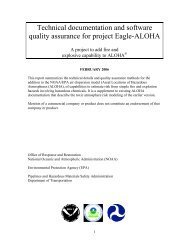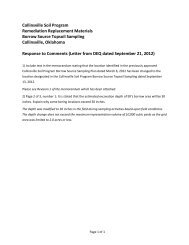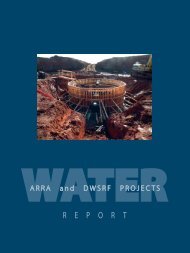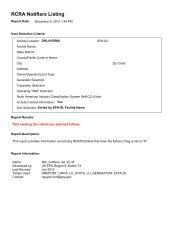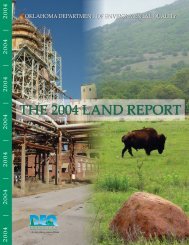Oklahoma Gas & Electric Muskogee Generating Station Best ...
Oklahoma Gas & Electric Muskogee Generating Station Best ...
Oklahoma Gas & Electric Muskogee Generating Station Best ...
Create successful ePaper yourself
Turn your PDF publications into a flip-book with our unique Google optimized e-Paper software.
<strong>Oklahoma</strong> <strong>Gas</strong> & <strong>Electric</strong><br />
<strong>Muskogee</strong> <strong>Generating</strong> <strong>Station</strong> – BART Determination<br />
May 28, 2008<br />
NOx Control<br />
Technology Option<br />
Table 3-9<br />
<strong>Muskogee</strong> Units 4 & 5<br />
NOx Average Visibility Cost Impact Evaluation<br />
Total Annual<br />
Cost<br />
Modeled<br />
Visibility<br />
Impairment*<br />
29<br />
Visibility<br />
Impairment<br />
Improvement<br />
from Baseline<br />
Average<br />
Improvement<br />
Cost<br />
Effectiveness<br />
($/yr) 98 th % ∆-dv* (dv) ($/dv/yr)<br />
Baseline -- 1.06 -- --<br />
LNB/OFA $4,183,600 0.32 0.74 $5.65 MM/dv<br />
LNB/OFA + SCR $61,591,200 0.14 0.92 $66.9 MM/dv<br />
* ∆-dv values included in this table represent the modeled visibility impacts only from NOx emissions<br />
associated with each NOx retrofit control scenario. Modeled visibility impairment at the Caney Creek Class I<br />
Area was used for the cost effectiveness evaluation because modeling indicated that the largest ∆-dv<br />
improvements would occur at Caney Creek.<br />
Although SCR control systems reduce modeled visibility impacts at the four Class I Areas, the<br />
incremental cost effectiveness of SCR control (with respect to visibility improvement) is very high.<br />
Incremental cost effectiveness of SCR control is in the range of $319 million per dv improvement<br />
at the Wichita Mountains. This cost is significantly higher than costs incurred at other BART<br />
applicable sources. A review of BART determinations at other coal-fired units suggests that BART<br />
cost effectiveness values are typically in the range of less than $1.0 million to approximately $13<br />
million per dv improvement. 14 The combination of low visibility impacts with LNB/OFA controls<br />
(less than 0.32 ∆-dv at all Class I Areas) and the high cost of SCR controls contribute to the large<br />
incremental cost effectiveness of SCR at the <strong>Muskogee</strong> <strong>Station</strong>.<br />
NOx Control<br />
Technology Option<br />
Table 3-10<br />
<strong>Muskogee</strong> Units 4 & 5<br />
NOx Incremental Visibility Cost Impact Evaluation<br />
Total Annual<br />
Cost<br />
Incremental<br />
Annual Cost<br />
Modeled<br />
Visibility<br />
Impairment<br />
Incremental<br />
Visibility<br />
Impairment<br />
Improvement<br />
Incremental<br />
Improvement<br />
Cost<br />
Effectiveness<br />
($/yr) ($/yr) 98 th % ∆-dv* (dv) ($/dv/yr)<br />
Baseline -- -- 1.06 -- --<br />
LNB/OFA $4,183,600 -- 0.32 -- --<br />
LNB/OFA + SCR $61,591,200 $57,407,600 0.14 0.18 $319 MM/dv<br />
* ∆-dv values included in this table represent the modeled visibility impacts only from NOx emissions associated with<br />
each NOx retrofit control scenario. Modeled visibility impairment at the Caney Creek Class I Area was used for the cost<br />
effectiveness evaluation because modeling indicated that the largest ∆-dv improvements would occur at Caney Creek.<br />
14 See e.g., BART evaluations for Xcel (Sherco, MN); Great River Energy (Coal Creek, ND); Trigen Energy<br />
Co. (CO); Entergy White Bluff Power Plant (AR).



